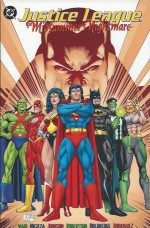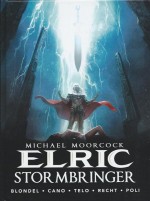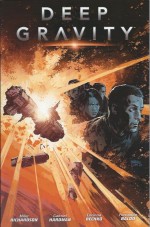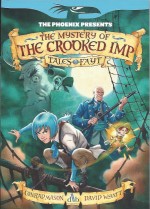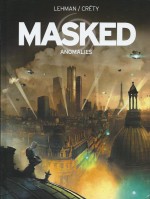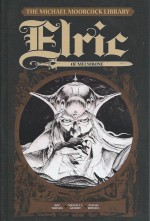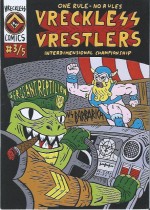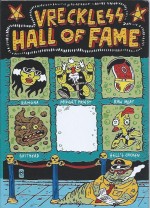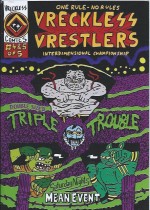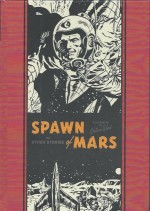
By Al Feldstein, Harry Harrison & Wallace Wood (Fantagraphics Books)
ISBN: 978-1-60699-805-2
EC began in 1944 when comicbook pioneer Max Gaines sold the successful superhero properties of his All-American Comics company – including Wonder Woman, Flash, Green Lantern and Hawkman – to half-sister National/DC, retaining only Picture Stories from the Bible. His plan was to produce a line of Educational Comics with schools and church groups as the major target market. He then augmented his core title with three more in similar vein: Picture Stories from American History, Science and World History. The worthwhile but unsustainable project was already struggling when he died in a boating accident in 1947.
His son William was eventually convinced to assume control of the family business and, with much support and encouragement from unsung hero Sol Cohen and multi-talented associate Al Feldstein, transformed the ailing enterprise into Entertaining Comics, consequently triggering the greatest qualitative leap forward in comicbook history…
After a few tentative false starts and abortive experiments, Gaines settled into a bold and impressive publishing strategy, utilising the most gifted illustrators in the field to tell a “New Trend†of stories aimed at an older, more discriminating audience.
From 1950 to 1954 EC was the most innovative and influential publisher in America, dominating the genres of science fiction, war, horror and crime. The company even added a new type of title and another genre with the creation of parody magazine Mad …
This 12th volume of the Fantagraphics EC Library compiles a mind-blowing catalogue of cosmic wonders courtesy of Wallace Allan Wood: one of the greatest draughtsmen and graphic imagineers our art form has ever produced.
Woody was a master of every aspect of the business. He began his career lettering Will Eisner’s Spirit strip, readily moving into pencilling and inking as the 1940s ended and, latterly, publishing. After years working all over the comicbook and syndicated strip industries, as well as in legitimate illustration, package-design and other areas of commercial art, he devised the legendary T.H.U.N.D.E.R. Agents franchise and even created one of the first adult independent comics with Witzend in the late 1960s.
The troubled genius carried the seeds of his own destruction, however. Woody’s life was one of addiction (booze and cigarettes), traumatic relationships, tantalisingly close but always frustrated financial security, illness and eventually suicide. It was as if all the joy and beauty in his existence stayed on the pages and there was none left for real life.
Although during his time with EC Wood became the acknowledged, undisputed Master of Science Fiction art in America, he was equally adept, driven and accomplished in the production of all genres.
This enticingly evocative collection reprints some of his best early science fiction and fantasy masterpieces, re-presented as always, in a lavish monochrome hardcover edition, with supplementary interviews, features and dissertations, beginning with ‘Spawn of Wood’ by Bill Mason, which dissects and appraises the yarns included with forensic discipline and unflinching insight.
Although the usual process at this time was for Gaines and Al Feldstein to plot stories before Feldstein meticulously scripted and laid out each tale for the artists, the worlds of wonder here begin their revelatory orbits with a chilling piece written and illustrated by Wood as ‘Dark Side of the Moon’ (from Weird Fantasy #15 September/October 1950) discloses how the fist lunar landing exposes an alien city of conquerors poised to attack…
Gaines & Al Feldstein were back in charge for ‘A Trip to a Star!’ (Weird Fantasy #16 November/December 1950) as an exploratory excursion far beyond the solar system leads to an astonishing mystery whilst ‘Return’ (Weird Science #15 January/February 1951) sees survivors of an antediluvian and previously unknown race show up on the brink of humanity’s atomic Armageddon to reveal what caused them to flee the planet in ages past…
‘Deadlock!’ was another all-Wood extravaganza (Weird Fantasy #17 January/February 1951), describing a gripping stalemate in space as mankind responded to its First Contact with another star-faring species with typical suspicion. Sadly, the strangers were more like us than different…
A traumatised survivor of the ‘Sinking of the Titanic!’ (Gaines, Feldstein & Wood from Weird Science #6 March/April 1951) built a time-machine to avert the tragedy and became a helpless pawn of destiny, whilst that same month in Weird Fantasy #6 ‘Rescued!’ saw a second ship of Earthly Argonauts fall foul of the cosmic irony which devastated their bold predecessors and ‘The Aliens!’ (Weird Science #7 May/June 1951) detailed another sidereal misapprehension when two belligerent alien species confronted each other and vowed eradication of their newfound foe and its homeworld. Sadly both were on a desolate part of Earth at the time…
“Red Scare†paranoia informed many tales from this time and ‘Breakdown!’ (Weird Fantasy #7, May/June 1951) is one of the best as a distraught wife tries to inform the authorities of imminent invasion only to walk straight into the mind-shatteringly hideous clutches of the infiltrators.
‘The Probers’ (Weird Science #8 July/August 1951) turns the tables on callous human scientists who jump to the wrong conclusions regarding the latest batch of alien guinea pigs whilst that same month in Weird Fantasy #8, all-Wood, ecologically astute saga ‘The Enemies of the Colony’ saw human pioneers on the Galactic Colonization Authority‘s new territory-world drive the wrong predator to extinction – and not live to regret it…
Extraterrestrial biological horror informed ‘The Gray Cloud of Death!’ (Gaines, Feldstein & Wood from Weird Science #9 September/October 1951) as an inimical and voracious thing invades the second ship to voyage to Venus, whilst that month in Weird Science #9 a tragic misunderstanding and itchy trigger-fingers signalled the end of refugees considered ‘The Invaders’ of our world in anther stark parable from Gaines, Feldstein & Wood…
The titular ‘Spawn of Mars’ (Gaines, Feldstein & Wood and also featured in WF #9) detailed the experiences of the first woman explorer on Mars as well as the thing that came back masquerading as her husband…
A brace of yarns from Weird Science #10 November/December 1951 begins with ‘The Maidens Cried’ as spacemen from Earth find themselves beguiled into the bizarre mating processes of beautiful butterfly women whilst ‘Transformation Completed’ offers a stunning moral fable wherein a possessive father uses his new discovery to get rid of his daughter’s “unworthy†suitor by converting him into a woman.
The paranoid Prof comes a cropper because he utterly underestimates his child’s capacity for love and sacrifice…
‘The Secret of Saturn’s Ring!’ was the first of a Gaines, Feldstein & Wood double-bill from Weird Fantasy #10 (November/December 1951), revealing what lurked within that celebrated debris field and how it portended horrific consequences for mankind, whilst ‘The Mutants!’ depicts our selfish bigotry in all its cruelty as the aberrations born in the atomic age are hounded off Earth…
‘The Conquerors of the Moon!’ Weird Science #11 January/February 1952 is a quintessential classic of the form as greedy industrialists steal a portion of Earth’s atmosphere to make the Moon cost-effectively habitable, destroying the birthplace of humanity and consequently laying the seeds of their own destruction, after which Weird Fantasy #11 from the same month offers both the irony-drenched tale of generational colonists undertaking ‘The Two-Century Journey!’ and a time-bending prophecy of inescapable atomic incineration in ‘The 10th at Noon’…
Wry and trenchant black humour resurfaced in ‘A Gobl is a Knoog’s Best Friend’ (Weird Science #12 March/April 1952) as the relationship between Earth spacers and the ship’s dog is misunderstood by aliens before – from the same issue – ‘The Android!’ showed that desire, deception and murder weren’t just facets of mere biology. That month in Weird Fantasy #12 ‘Project… Survival!’ played word games with mythology as mankind sought to survive Armageddon by selecting fragments of Earth to survive aboard rocketship A.R.C.-1 and ‘The Die is Cast!’ gets crushingly literal as explorers find doom and destruction on a desolate flatland plagued by moving mountains…
Shock SuspenStories launched in 1952 and was an anthological anthology – by which I mean that Gaines and Feldstein used it to highlight their other short-story titles by having horror, crime and sci fi yarns in each issue. From #2 (April/May) comes grisly parable ‘Gee Dad… It’s a Daisy!’ which saw explorers find a planet where the inhabitants are as capricious and inadvertently cruel as any earthling 10-year old…
When Wood first began working he formed a studio with a college buddy who would eventually go on to become one of America’s most popular science fiction authors. Working together as writers, pencillers, inkers and letterers it was often impossible to tell who did what.
Short text feature ‘The Enigma of Harrison the Artist’ by Bill Mason covers that uniquely fertile collaboration and includes a glorious Harry Harrison cartoon of his new colleagues in the pulp sci fi watering hole “the Hydra Club†before this volume concludes with a selection of Wood/Harrison EC collaborations beginning with ‘Dream of Doom’ (Harrison script & pencils, Wood inks from Weird Science #12 March/April 1950).
Here a pair of comic creators fall out over creator credit and persistent nightmares after which ‘Only Time Will Tell’ (possibly Gaines, Feldstein with Harrison & Wood from Weird Fantasy #13 May/June 1950) finds a scientist caught in an inescapable time-loop after popping back in time to help himself invent time travel…
Weird Science #13 July/August 1950 unleashed ‘The Meteor Monster’ (Harrison & Wood) which saw a small town slowly succumb to the mental domination of a thing from another world whilst ‘The Black Arts’ (with Harrison inking Wood from Weird Fantasy #14 July/August 1950) offered a rare supernatural horror outing wherein a mousy man tried to used sorcery to get a girlfriend… with disastrous results.
The comicstrip chronicles conclude with an all-Harrison affair as the ‘Machine From Nowhere’ (Weird Science #15 September/October 1950) offers an extremely rare upbeat ending as two scientists stifle their perfectly natural suspicions to help a little flying robot steal uranium for purposes unknown…
Following a delightful ‘Wallace Wood’ caricature by EC colourist and “office girl†Marie Severin, historian S.C. Ringgenberg provides a detailed history of the flawed genius in ‘Wallace Wood’ and this truly captivating compilation closes on another set of ‘Behind the Panels: Creator Biographies’ by Janice Lee and Bill Mason and Ted White’s ‘Crime, Horror, Terror, Gore, Depravity, Disrespect for Established Authority – and Science Fiction Too!: ‘The Ups and Downs of EC Comics: A Short History’ – a comprehensive run-down of the entire EC phenomenon.
The short, sweet, cruelly curtailed EC back-catalogue has been revisited ad infinitum in the decades since its demise. Those amazing yarns changed not just comics but also infected the larger world through film and television to convert millions into dedicated devotees still addicted to New Trend tales.
Whether you are an aged EC Fan-Addict, just a nervous newbie, or simply a mere fan of brilliant stories and sublime art, Spawn of Mars is a book no sane and sensible reader can afford to be without.
Spawn of Mars and Other Stories © 2015 Fantagraphics Books, Inc. All contents © 2015 Fantagraphics Books, Inc. unless otherwise noted. All comics stories and illustrations © 2015 William M. Gaines Agent, Inc., unless otherwise noted. All other material © 2015 the respective creators. All rights reserved.
